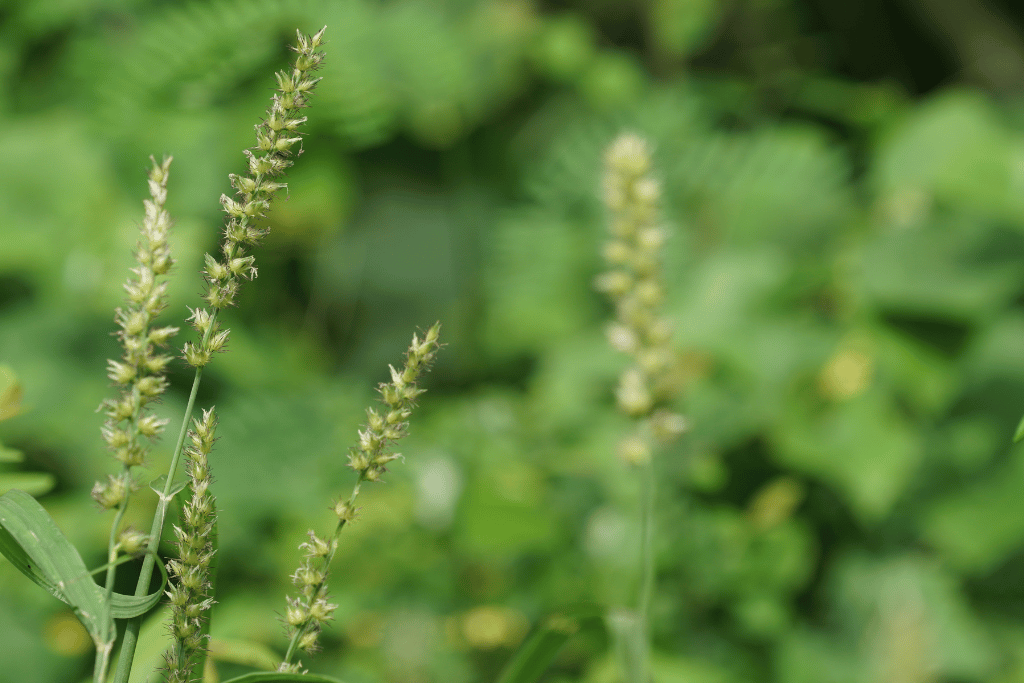
If you’ve ever found yourself staring at a yellow cucumber and wondering – can you eat yellow cucumbers, you’re not alone. Yellow cucumbers can be a bit puzzling, but stress not, as I’m here to guide you through this crunchy dilemma.
Cucumbers are a popular vegetable enjoyed in salads, sandwiches, and as a refreshing snack. However, when you spot a yellow cucumber, it can raise questions about its edibility. So, to clear your doubts, I’ll be covering yellow cucumbers in detail, covering everything from their appearance to culinary uses, and, most importantly, whether it’s safe to eat them.
So, let’s get started!
What Are Yellow Cucumbers?
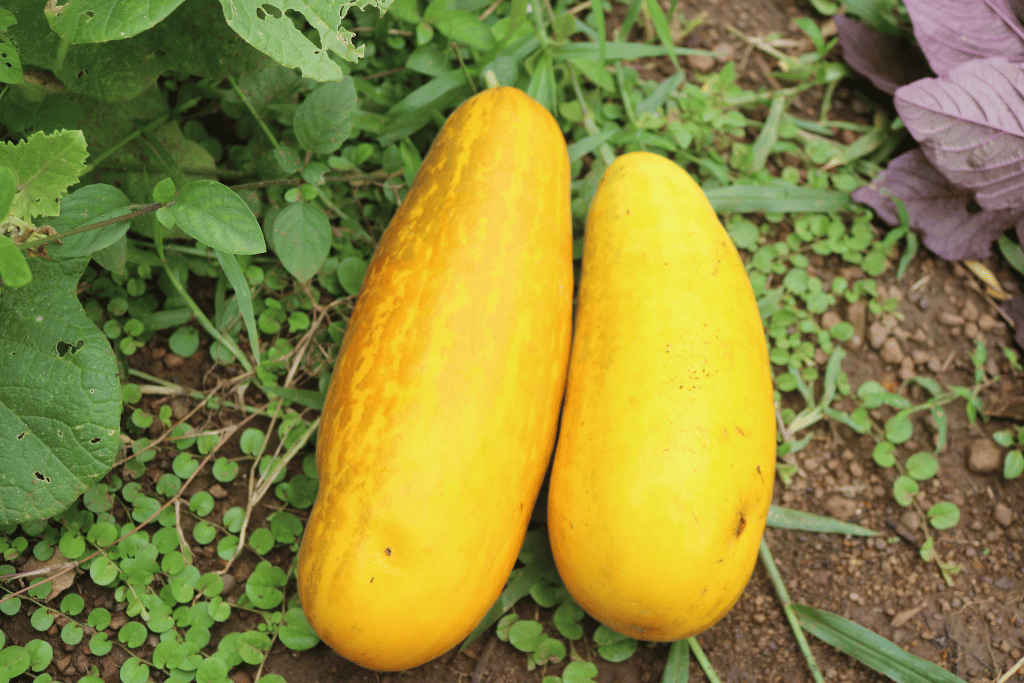
Yellow cucumbers, as the name suggests, are cucumbers that have taken on a yellow hue. Unlike their green cucumbers, they have a vibrant yellow skin and flesh. These cucumbers are not a separate species but rather a variation of the common cucumber. They come in different shapes and sizes, just like green cucumbers, and their taste can vary from mild to slightly sweet.
One common misconception is that yellow cucumbers are merely overripe green cucumbers. While overripe green cucumbers can turn yellow and become bitter, true yellow cucumbers are a distinct variety. So, if your cucumber started off yellow, it’s not necessarily a sign of spoilage.
Are Yellow Cucumbers Safe to Eat?
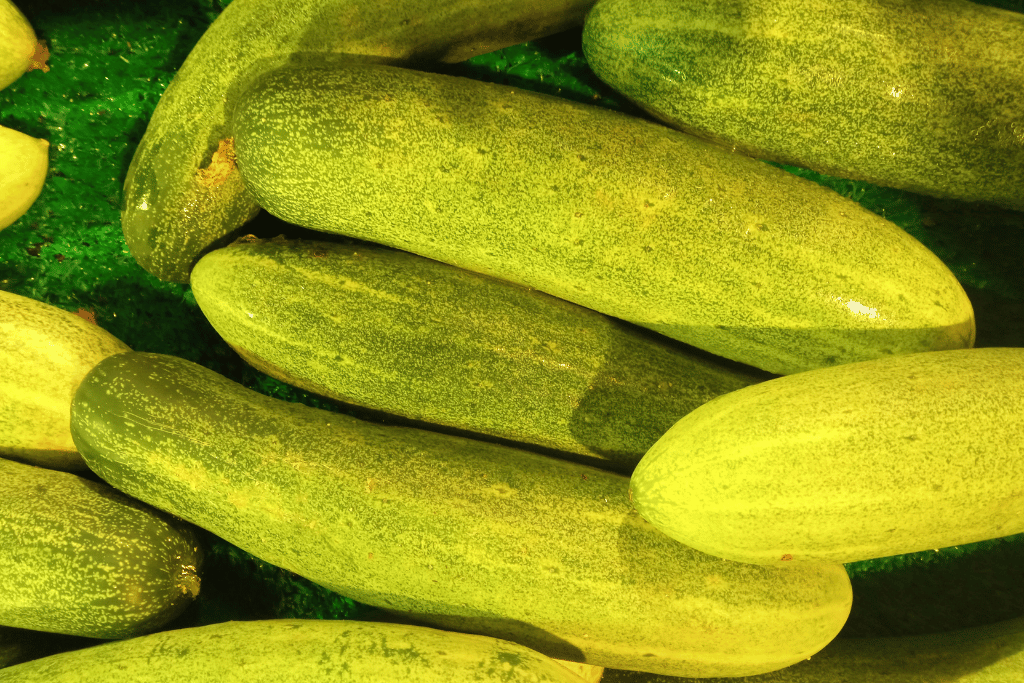
Now that we’ve covered the basics of yellow cucumbers, let’s go deeper into the safety aspect, addressing concerns about whether you can eat a yellow cucumber, and exploring what lies beneath that vibrant yellow skin.
Can You Eat Yellow Cucumbers?
The short answer is yes, you can eat yellow cucumbers, and they are safe for consumption. However, there are a few important considerations to keep in mind to ensure you’re enjoying a tasty and healthy treat.
Addressing Concerns About Yellow Cucumbers
Potential Spoilage or Rot: Like any fresh produce, cucumbers can spoil over time, and this includes yellow cucumbers. When assessing the edibility of a yellow cucumber, it’s crucial to inspect it carefully. Look for signs of spoilage, such as a mushy or slimy texture, which are indicators that the cucumber may have gone bad.
Additionally, check for any visible mold on the skin, as this is a clear sign that the cucumber is no longer safe to eat.
Differences Between Yellow and Green Cucumbers: It’s essential to distinguish between naturally yellow cucumbers and overripe green cucumbers. As mentioned earlier, yellow cucumbers are a distinct cucumber variety known for their yellow skin and flesh. They are perfectly safe to consume when ripe. On the other hand, overripe green cucumbers can turn yellow and develop a bitter taste, making them less enjoyable to eat. Therefore, it’s important not to confuse the two.
What Should a Cucumber Look Like from Inside?
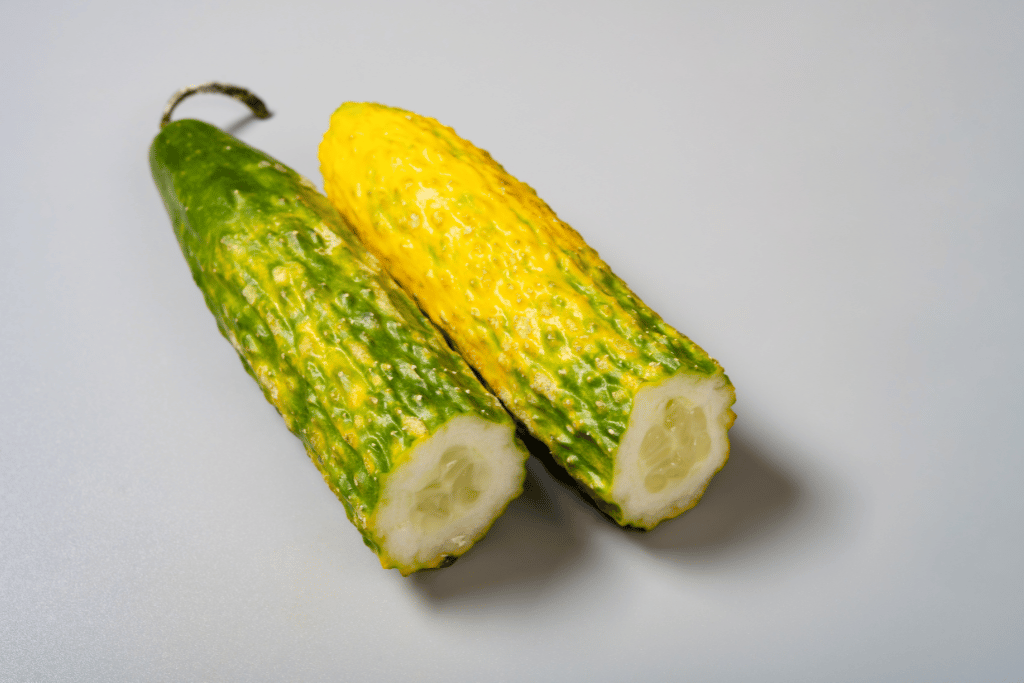
Moving forward, it’s equally important to know what a healthy and delicious cucumber should look like when you slice it open. This knowledge will help you confidently identify cucumbers that are perfect for your culinary creations, ensuring you can enjoy their fresh and crisp qualities.
Consistent Coloration:
When you cut into a yellow cucumber, you should notice that the vibrant yellow color of the skin extends uniformly to the flesh inside. Unlike some fruits and vegetables with different colored interiors, yellow cucumbers maintain their sunny hue throughout. This consistency is a hallmark of these delightful vegetables.
Crisp Texture:
A fresh cucumber, whether yellow or green, should have a crisp and crunchy texture. The flesh should be firm and snap when you bite into it. The crispness of a cucumber adds to its appeal, whether you’re eating it as a snack or incorporating it into your dishes.
Well-Formed Seeds:
Cucumbers, including yellow ones, naturally contain seeds. When you slice into a cucumber, you’ll find that the seeds are present but should be well-formed and distributed evenly throughout the flesh. They should not be overly large, swollen, or excessive in number. Healthy cucumber seeds are part of the cucumber-eating experience, providing a satisfying crunch.
Fresh Aroma:
Just as with external inspections, your sense of smell can be a valuable tool when assessing the quality of a cucumber from the inside. A fresh cucumber should emit a clean and cucumber-like aroma. This pleasant scent is indicative of its freshness and suitability for consumption. If you detect any off or unpleasant odors, it may be a sign of deterioration or spoilage.
Identifying Edible Yellow Cucumbers
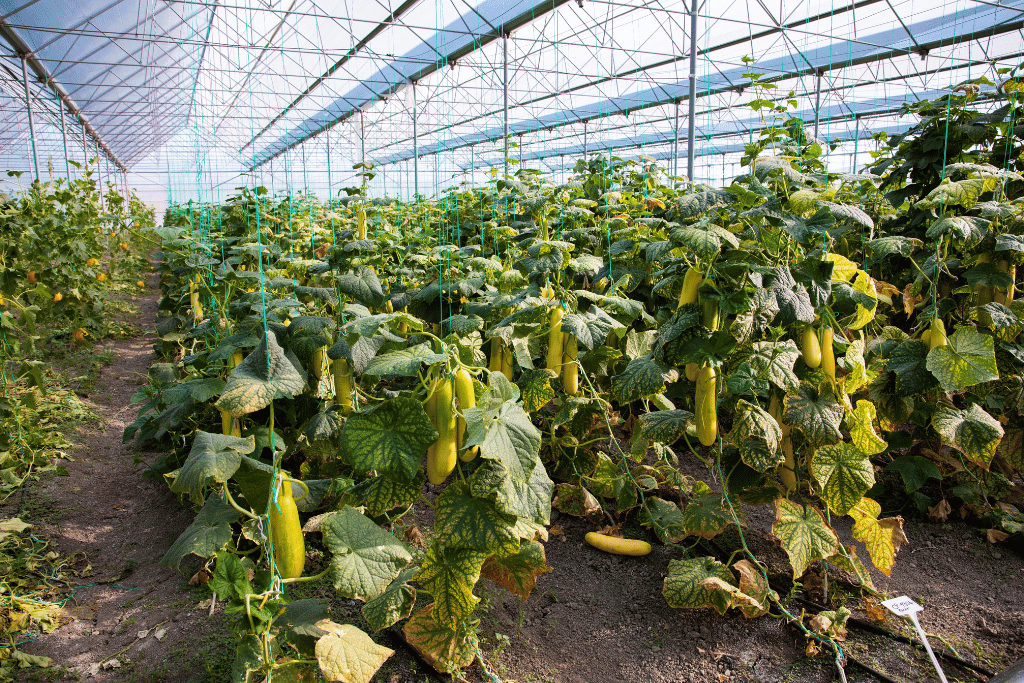
Identifying whether a yellow cucumber is fit for consumption is crucial to avoid any culinary disappointments or potential health issues. Here’s how to distinguish edible yellow cucumbers from those that should be discarded:
Check for Firmness and Texture
One of the primary indicators of a cucumber’s freshness is its firmness and texture. When you gently squeeze a yellow cucumber, it should feel firm but not overly hard. A ripe yellow cucumber should yield slightly to pressure but still maintain its shape. If you find that the cucumber is excessively soft or mushy to the touch, it has likely passed its prime and may not be enjoyable to eat.
Inspect the Skin
The skin of a yellow cucumber can reveal a lot about its edibility. Healthy yellow cucumbers should have smooth, unblemished skin. Run your fingers over the surface, checking for any irregularities, bruises, soft spots, or discolorations. These imperfections can be signs of deterioration or spoilage. If you encounter a cucumber with such issues, it’s best to err on the side of caution and avoid consuming it.
Use Your Nose
Your sense of smell can be a valuable tool in assessing the quality of a yellow cucumber. A fresh and edible cucumber should emit a pleasant, cucumber-like aroma. Take a moment to give it a sniff. If the cucumber smells off, unpleasant, or moldy, it’s a clear indication that it has gone bad and should not be eaten.
Taste and Flavor
Yellow cucumbers, while similar in taste to green cucumbers, may have subtle differences in flavor. They tend to be milder, with a delicate sweetness that can be quite refreshing. However, if you take a bite and find that the cucumber tastes excessively bitter, sour, or off, it’s a sign that it may have overripened or spoiled. In such cases, it’s best to discard the cucumber.
It’s important to note that even if a yellow cucumber passes the visual and tactile tests, its flavor should be the ultimate confirmation of its quality. Trust your taste buds, and if something doesn’t seem quite right, it’s better to be safe than sorry.
Enjoying the Unique Qualities
Yellow cucumbers, with their distinct color and subtle flavor differences, can offer a delightful culinary experience. Embrace their uniqueness in your dishes and savor the variation they bring to your meals. Whether you slice them for salads, pickle them, or include them in other recipes, yellow cucumbers can be a flavorful addition to your culinary repertoire.
Culinary Uses of Yellow Cucumbers
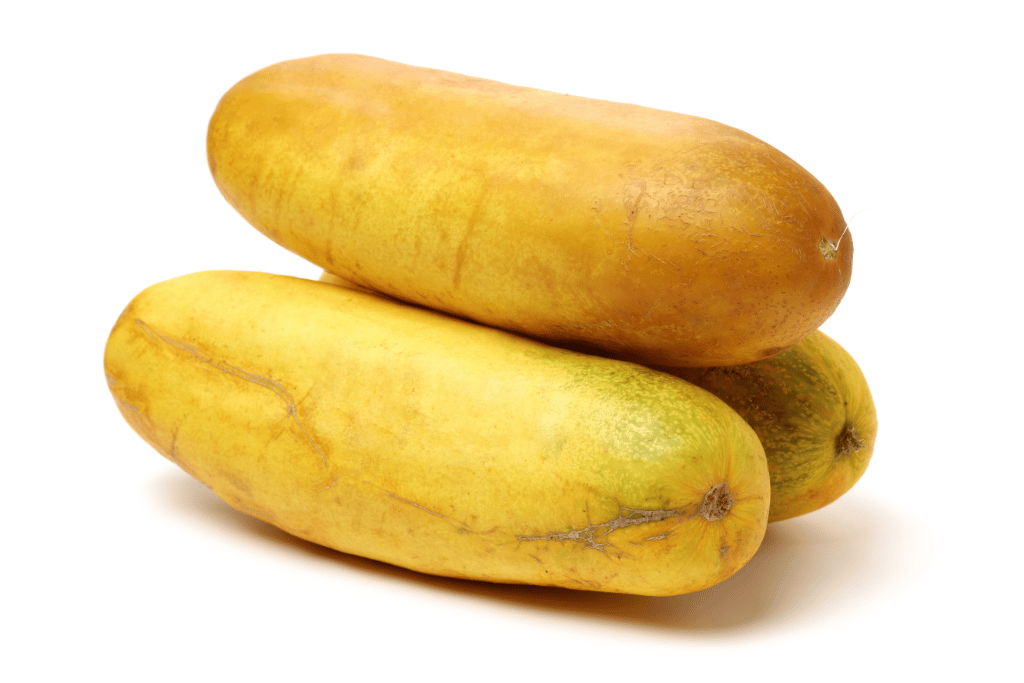
Now that you’re confident in identifying safe and delicious yellow cucumbers, let’s explore the exciting culinary possibilities they offer. We’ll also address the question of how to eat yellow cucumbers and what to expect when you slice into one.
Slicing into a Yellow Cucumber
When you slice into a yellow cucumber, you’ll notice that the vibrant yellow color extends from the skin to the flesh inside. Unlike some other fruits and vegetables that may have different colored interiors, yellow cucumbers maintain their sunny hue throughout. This consistent coloration is a hallmark of these delightful vegetables.
How to Eat Yellow Cucumbers
Yellow cucumbers can be enjoyed in various ways, just like their green counterparts. Here are some delicious culinary uses for yellow cucumbers:
- Fresh in Salads: One of the simplest and most refreshing ways to enjoy yellow cucumbers is by incorporating them into salads. Slice them into rounds or julienne strips to add a burst of color and a subtle, sweet flavor to your salad mix. Their crisp texture pairs beautifully with greens, tomatoes, and your choice of dressing.
- Pickling: Yellow cucumbers are excellent candidates for pickling. Their mild flavor allows them to absorb the flavors of the pickling brine, creating crunchy and tangy pickles. You can make dill pickles, bread-and-butter pickles, or even experiment with unique spice blends for a personalized touch.
- Salsas and Relishes: Dice or finely chop yellow cucumbers to create vibrant salsas and relishes. Combine them with ingredients like tomatoes, onions, cilantro, and lime juice for a zesty topping that pairs wonderfully with grilled meats or fish. The cucumber’s mild sweetness balances the heat of spicy salsas.
- Smoothies: Believe it or not, yellow cucumbers can be a surprising addition to your morning smoothie. They bring a refreshing, hydrating element to your drink, and their mild flavor won’t overpower other ingredients. Simply blend them with your favorite fruits and yogurt for a cool and nutritious beverage.
What to Expect When Eating Yellow Cucumbers?
When you take a bite of a yellow cucumber, you’ll experience a mild and slightly sweet flavor. The texture is crisp, making it an enjoyable snack on its own or as a complement to other ingredients. The skin of yellow cucumbers is thin and tender, so there’s no need to peel them unless you prefer to do so.
The consistent yellow color of these cucumbers extends throughout the flesh, ensuring a visually appealing addition to your dishes. This can be particularly appealing when you’re creating colorful salads or pickles.
Incorporating yellow cucumbers into your culinary repertoire allows you to introduce a unique twist to classic recipes. Their distinct flavor and striking appearance can elevate your dishes and make them stand out.
Storing and Preserving Yellow Cucumbers
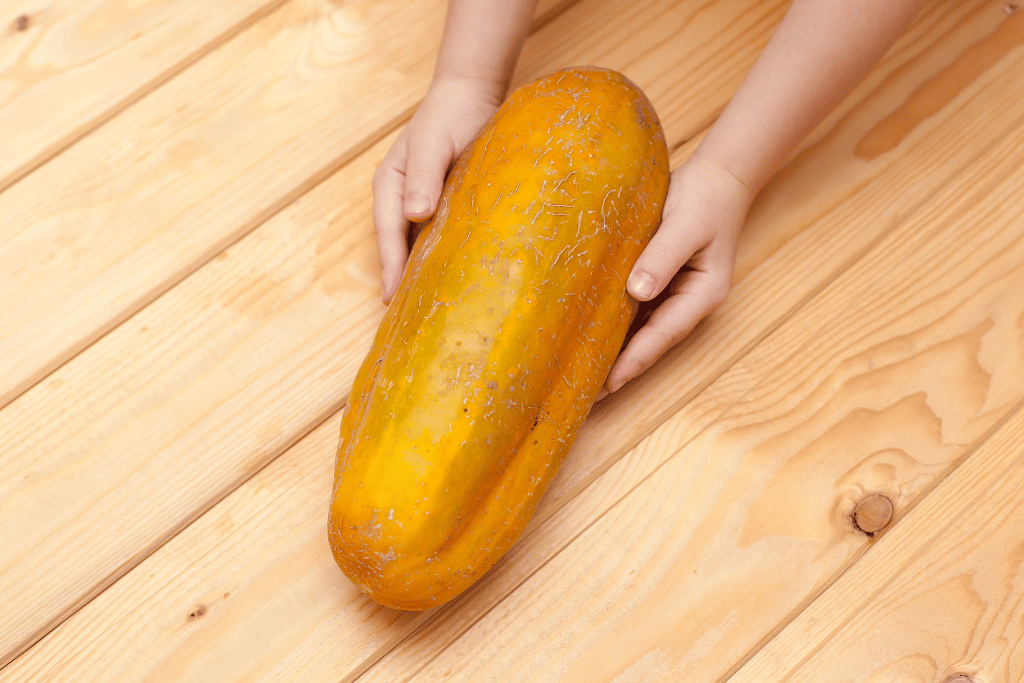
So far, we’ve learned how to select, identify, and enjoy the deliciousness of yellow cucumbers. Now, let’s find out how to properly store and preserve these vibrant vegetables to maximize their freshness and extend their shelf life.
Refrigeration Tips
Yellow cucumbers, like their green counterparts, benefit from being stored in the refrigerator. Here’s how to do it right:
Wrap and Protect: If you have a whole yellow cucumber that you haven’t used entirely, it’s a good idea to wrap it tightly in plastic wrap or place it in a sealed plastic bag. This helps prevent moisture loss and keeps the cucumber from drying out.
Vegetable Crisper Drawer: Store your wrapped or bagged cucumbers in the vegetable crisper drawer of your refrigerator. This compartment maintains a higher humidity level, which is ideal for cucumbers.
Temperature: Keep your refrigerator set at a temperature of around 40°F (4°C). Cucumbers are sensitive to colder temperatures and can develop chilling injuries if exposed to temperatures below this range.
By following these refrigeration tips, you can maintain the crispness and freshness of your yellow cucumbers for an extended period.
Airtight Containers
If you’ve sliced or chopped your yellow cucumbers and plan to use them later, consider placing them in airtight containers. Airtight containers help preserve their texture and prevent them from absorbing odors from other foods in the fridge.
Pickling for Long-Term Preservation:
If you have an abundance of yellow cucumbers and want to enjoy their goodness for months to come, consider pickling them. Pickling is an excellent way to preserve cucumbers, including yellow ones. Here’s a basic pickling process:
- Wash and Slice: Wash the yellow cucumbers thoroughly and slice them into your desired shape (rounds, spears, etc.).
- Prepare the Brine: In a saucepan, combine water, vinegar, salt, sugar, and any desired spices. Bring the mixture to a boil, then let it cool.
- Pack the Jars: Pack the sliced cucumbers into sterilized glass jars, leaving some headspace. Pour the cooled brine over the cucumbers, ensuring they are fully submerged.
- Seal and Store: Seal the jars with sterilized lids and bands. Store the jars in a cool, dark place, like a pantry or cellar. Let the pickles sit for a few weeks to develop their flavors before enjoying them.
Pickled yellow cucumbers make a tasty and crunchy addition to sandwiches, burgers, and charcuterie boards.
Signs that Show a Yellow Cucumber is Bad from the Inside
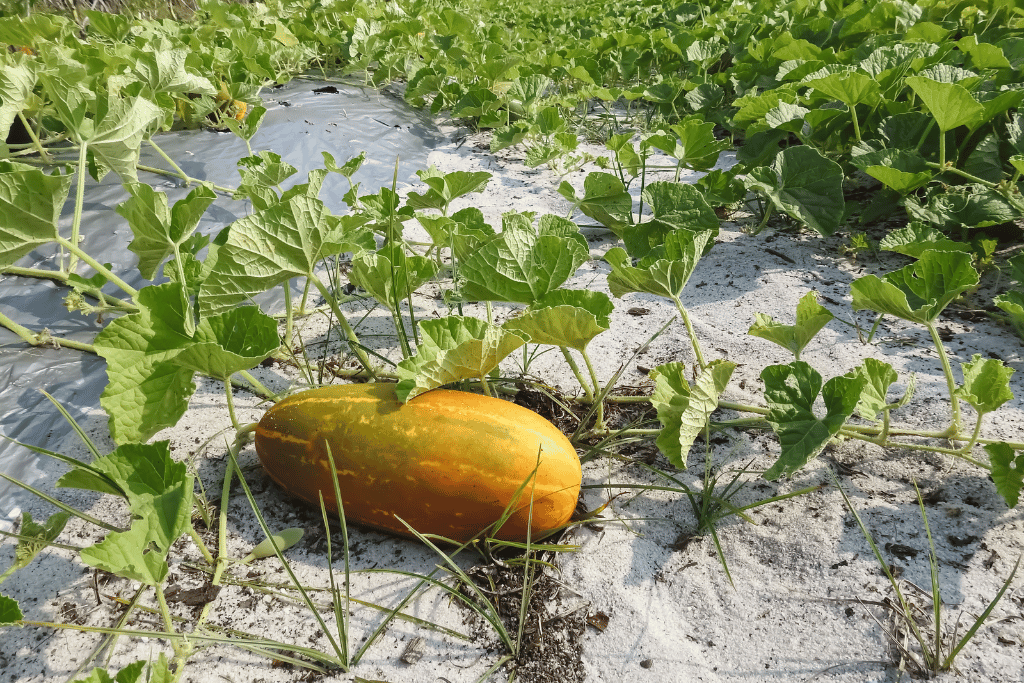
While we’ve discussed how to select and enjoy yellow cucumbers, it’s equally important to know how to spot signs of spoilage or deterioration from the inside. Here, we’ll explore specific indicators that can help you determine if a yellow cucumber has gone bad on the inside, ensuring your culinary creations are safe and enjoyable.
1. Mushy Texture:
When you cut into a yellow cucumber and find that the flesh is excessively soft or mushy, it’s a clear sign that the cucumber is no longer in good condition. Fresh cucumbers should have a crisp and crunchy texture. If the cucumber feels slimy or lacks firmness, it’s best to discard it.
2. Excessive Seeds:
While cucumbers naturally contain seeds, an overabundance of seeds or seeds that are unusually large can indicate overripeness. Overripe cucumbers tend to have enlarged seeds and may not offer the best texture or flavor.
3. Bitter Taste:
Cucumbers, both yellow and green, should have a refreshing, mild flavor. If you take a bite of a yellow cucumber and encounter an excessively bitter or unpleasant taste, it’s a strong indication that the cucumber may have overripened or spoiled. This bitterness can be a result of cucurbitacin, a naturally occurring compound that can increase in concentration as cucumbers age.
4. Off-Putting Odor:
Give your yellow cucumber a sniff before using it. A fresh cucumber should have a clean, cucumber-like aroma. If you detect any off-putting or foul odors, it’s a clear sign that the cucumber has deteriorated on the inside and is no longer suitable for consumption.
5. Visible Discoloration:
While this is an external indicator, it can provide insights into the cucumber’s internal condition. If you notice significant discoloration, such as dark or brownish streaks inside the cucumber, it’s likely that the deterioration has affected the interior as well.
Keep in mind that while these signs can help you identify a bad yellow cucumber from the inside, they are best used in conjunction with external inspections, such as checking for firmness and examining the skin for blemishes or mold. A combination of these assessments will ensure that you’re enjoying the freshest and safest yellow cucumbers in your dishes.
What are the Causes for Cucumbers to Turn Yellow?
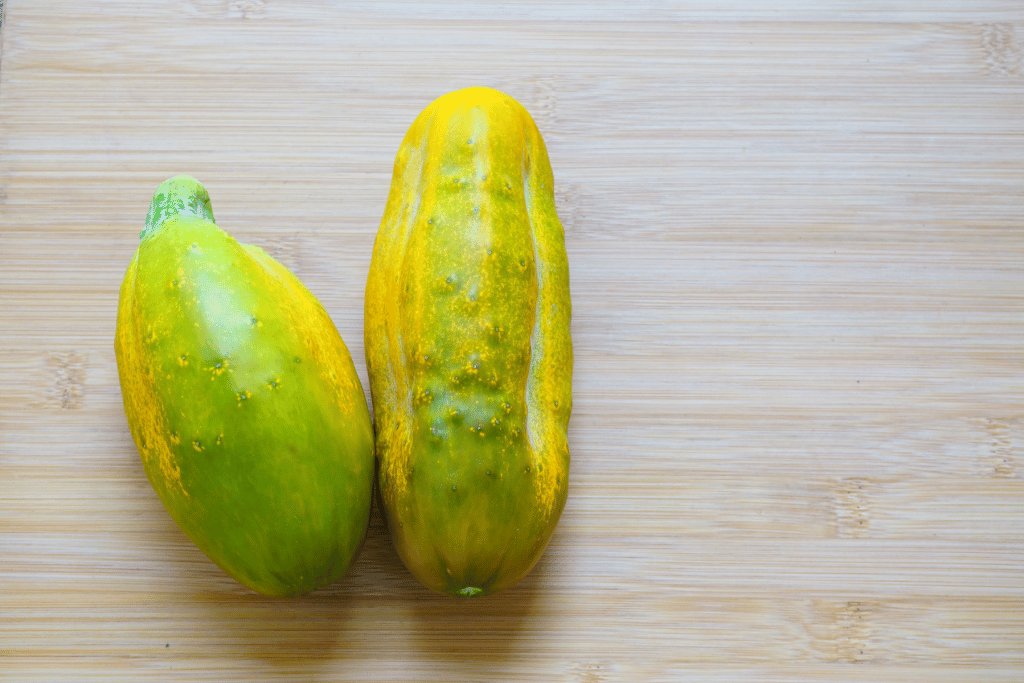
Yellow cucumbers can be a puzzling sight, especially when you’re used to seeing the vibrant green variety. However, there are several factors and reasons that can cause cucumbers to turn yellow.
1. Ripeness and Varietal Differences:
One of the primary causes of yellow cucumbers is ripeness. Some cucumber varieties naturally ripen to a yellow or pale yellow color. These cucumbers are perfectly safe to eat and have a slightly different flavor profile compared to green cucumbers.
They are often milder in taste and have a unique sweetness. If your cucumber started off yellow, it’s likely a result of its specific variety and is not a cause for concern.
2. Overripeness:
On the other hand, green cucumbers can turn yellow when they become overripe. Overripe cucumbers lose their crispness and develop a bitter taste, which can be less enjoyable. If you find a yellow cucumber that was originally green, it may have been left on the vine for too long or stored improperly, causing it to overripen.
3. Environmental Factors:
Yellowing cucumbers can also be influenced by environmental factors such as temperature and sunlight exposure. Cucumbers that are subjected to excessive heat and sunlight can develop a yellowish or pale appearance on the side that receives the most sun. While this may affect the appearance, it doesn’t necessarily indicate spoilage or reduced edibility.
4. Disease or Pest Damage:
Cucumbers can sometimes turn yellow due to disease or pest damage. In such cases, the yellowing is often accompanied by other visible signs of distress, such as wilting, blemishes, or discoloration. If you suspect disease or pest issues, it’s best to consult with a gardening or agriculture expert for appropriate remedies.
5. Nutrient Deficiencies:
Nutrient deficiencies in the soil can also lead to cucumber discoloration, including yellowing. Ensuring that cucumber plants receive the necessary nutrients through proper soil management and fertilization can help prevent this issue.
Risks of Disease-Related Issues with Yellow Cucumbers
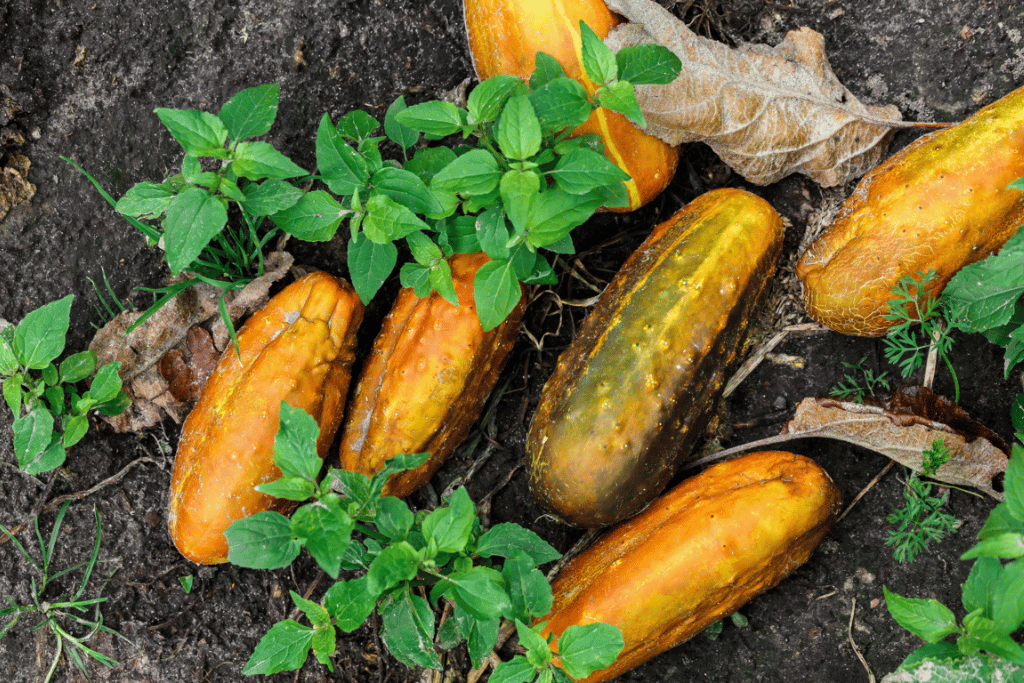
While yellow cucumbers can be a delightful addition to your culinary creations, it’s important to be aware of the potential disease-related risks associated with cucumbers. These risks primarily arise when cucumbers turn yellow due to overripeness or specific diseases affecting the plant. Let’s explore these issues in detail.
1. Food Poisoning Due to Bacterial Growth:
As cucumbers overripen, they become more susceptible to bacterial growth, which can pose a risk of food poisoning. Bacterial wilt, in particular, can affect cucumbers when they are past their prime. To reduce the risk of foodborne illnesses when consuming yellow cucumbers:
- Thoroughly Wash Cucumbers: It’s essential to clean and wash yellow cucumbers properly before consuming them. Use clean, running water to rinse off any potential contaminants on the surface.
- Inspect for Soft Spots or Mold: Visually inspect the cucumber for any soft spots or mold growth, as these can be indicators of harmful bacteria. If you encounter these issues, it’s best to discard the cucumber.
2. Viral or Fungal Diseases:
Yellow cucumbers can also result from viral or fungal diseases affecting the cucumber plants. These diseases not only impact the appearance of the cucumber but can also affect its nutritional value and safety for consumption.
Here’s how to mitigate these risks:
- Remove Affected Plants: If you notice viral or fungal diseases affecting your cucumber plants, it’s crucial to promptly remove and dispose of the affected plants properly. This prevents the diseases from spreading to the rest of your cucumber patch.
- Maintain Air Circulation: Adequate air circulation is essential for preventing viral and fungal diseases in cucumber plants. If you’re using straw as garden mulch, periodically move it around to promote air circulation and reduce moisture buildup, which can create favorable conditions for these diseases.
By being vigilant about disease-related risks and practicing proper cucumber plant care, you can help ensure the safety and quality of your yellow cucumbers.
Can You Prevent Cucumbers from Turning Yellow?
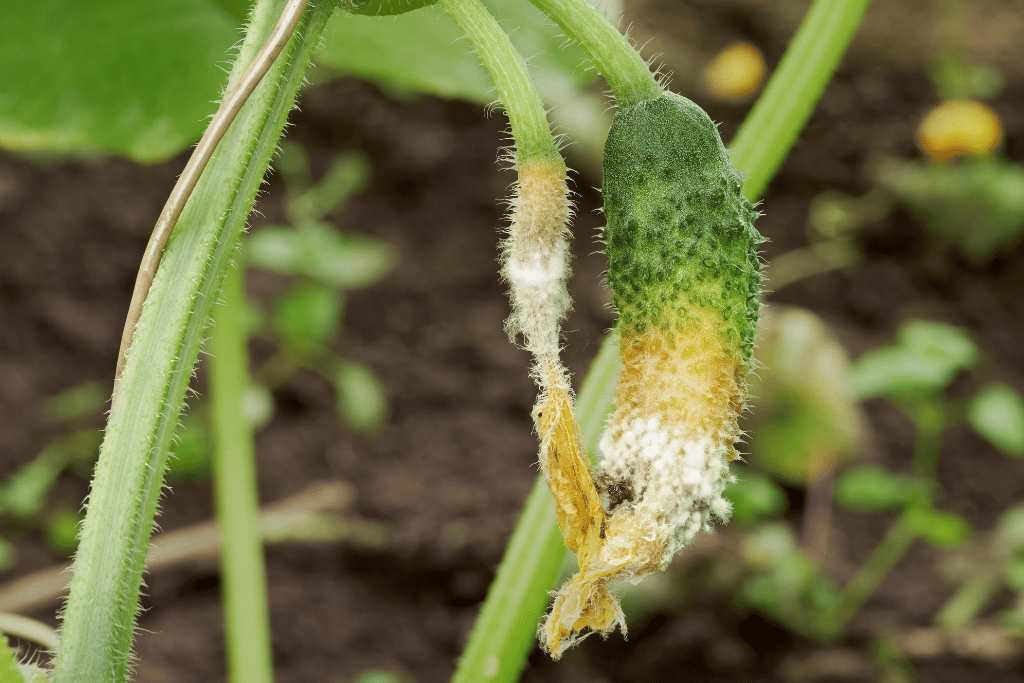
Preventing cucumbers from turning yellow can be challenging because some factors, like varietal characteristics or environmental conditions, are beyond your control. However, there are steps you can take to minimize the likelihood of cucumbers turning yellow prematurely. Let’s explore these preventive measures:
1. Proper Harvesting:
Harvest your cucumbers at the peak of ripeness. For yellow cucumber varieties, this means harvesting them when they are naturally yellow. For green cucumbers, pick them before they overripen and turn yellow. Regularly inspect your cucumber plants and harvest ripe cucumbers promptly.
2. Soil and Water Management:
Cucumbers need consistent moisture to thrive, but they don’t like to sit in waterlogged soil. Ensure your garden soil has good drainage to prevent waterlogging. Consistent watering can help prevent stress on cucumber plants, which can lead to yellowing.
Applying mulch around your cucumber plants can help regulate soil moisture and temperature. Mulch also reduces soil splashing, which can prevent the spread of diseases that cause yellowing.
3. Pest and Disease Management:
Use appropriate pest control methods to protect your cucumber plants from pest infestations. Some pests can transmit diseases that affect cucumbers.
Avoid planting cucumbers in the same location year after year. Crop rotation helps prevent the buildup of soilborne diseases that can lead to yellowing.
4. Fertilization:
Ensure your cucumber plants receive balanced nutrition. Too much or too little of certain nutrients can stress the plants and affect their health.
5. Pruning and Trellising:
Properly pruning and trellising cucumber plants can improve air circulation, reduce disease risk, and prevent cucumbers from touching the ground, where they are more susceptible to pests and diseases.
Best Practices for Preventing Yellow Cucumbers
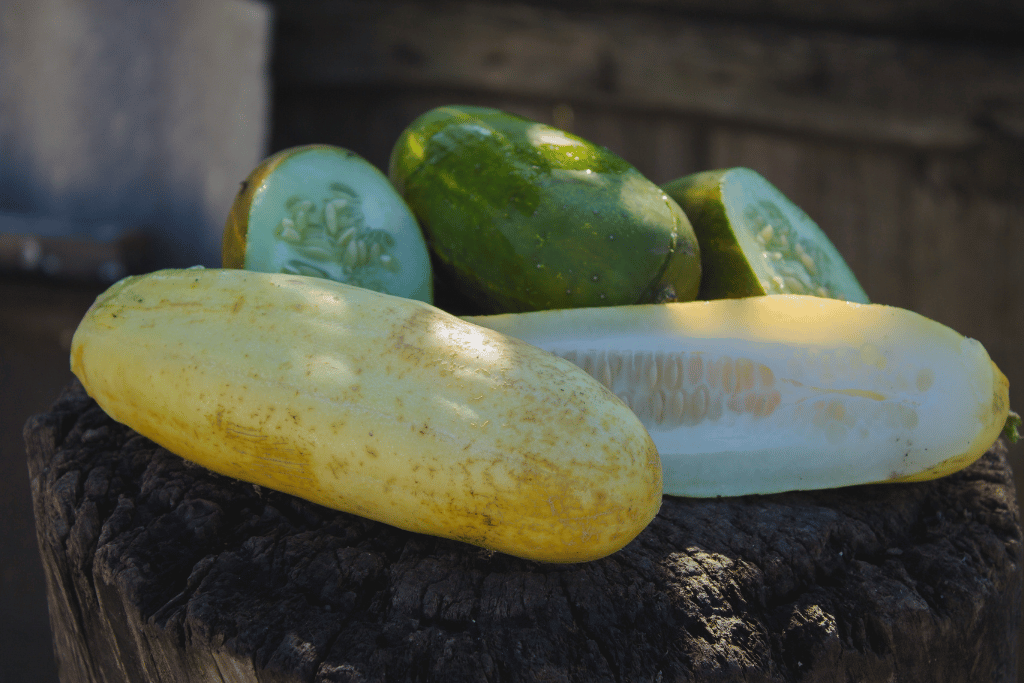
To keep your cucumber harvest vibrant and green, it’s important to follow a set of best practices aimed at maintaining the health of your cucumber plants and reducing the risk of encountering prematurely yellow cucumbers. Here are some key practices to consider:
1. Maintain Proper Watering:
Cucumbers need consistent moisture to thrive, but it’s crucial to avoid waterlogged soil. Ensure your garden soil has good drainage to prevent water buildup, which can stress the plants and lead to yellowing.
2. Follow a Consistent Crop Rotation:
Avoid planting cucumbers in the same location year after year. Crop rotation can help prevent the buildup of soilborne diseases and pests that contribute to yellowing.
3. Maintain Good Air Circulation:
Properly prune and trellis your cucumber plants to improve air circulation. This can reduce the risk of diseases and help maintain cucumber health.
4. Select Varieties that are Well Suited to Your Climate and Soil:
Choose cucumber varieties that are known to thrive in your specific climate and soil conditions. This can help ensure healthy and vigorous growth.
Learn more about: Cucumber Plant Stages
5. Maintain Room Temperature:
After harvesting cucumbers, store them at room temperature rather than in the refrigerator. Refrigeration can accelerate the yellowing process.
6. Keep a Balanced Fertilization Routine:
Ensure your cucumber plants receive balanced nutrition. Too much or too little of certain nutrients can stress the plants and affect their health. Follow recommended fertilization practices for cucumbers.
7. Provide Enough Inches of Water:
When watering your cucumber plants, aim to provide sufficient moisture. Deep watering encourages root development and helps the plants withstand stress.
8. Use a Food Processor to Puree Overripe Cucumbers for Dips or Sauces:
If you find overripe cucumbers in your garden, don’t let them go to waste. Puree them using a food processor and use the puree in dips, sauces, or even in soups. This way, you can still enjoy their flavor and reduce food waste.
Final Words
The question “can you eat yellow cucumbers” should no longer be a cause for uncertainty. These colorful cucumbers are not only edible but also offer a delightful and unique addition to your culinary repertoire. By incorporating them into your dishes, you can infuse a burst of sunshine both in terms of color and flavor.
So, next time you come across a yellow cucumber, remember that it’s not just a decorative novelty; it’s a delicious and nutritious option that can elevate your meals to a whole new level.
FAQs About Yellow Cucumbers
Is a yellow cucumber safe to eat if it’s yellow inside?
Yes, a cucumber can turn yellow inside as it ripens, and it is generally safe to eat. However, the taste and texture may differ from a typical green cucumber. Some people prefer the milder taste of yellow cucumbers, while others prefer them when they are still green and crisp.
Can you eat a yellow cucumber with yellow skin?
Yes, you can eat a cucumber with yellow skin. The color of the skin can change as the cucumber matures, but it is typically safe to eat. However, it’s essential to check for any signs of spoilage or overripeness, such as mushiness or an off-putting odor, before consuming it. If the cucumber looks and smells fine, it should be safe to eat, regardless of the color of the skin.
Are there any health concerns with eating yellow cucumbers?
Generally, there are no specific health concerns associated with eating yellow cucumbers. However, like with any food, it’s essential to ensure they are fresh and not spoiled. If a yellow cucumber shows signs of mold, rot, or a strong, unpleasant odor, it’s best to discard it to avoid any potential health risks.
Do yellow cucumbers taste different from green cucumbers?
Yes, yellow cucumbers can have a slightly different taste compared to green cucumbers. They are often milder and less bitter, which some people find preferable. The taste may also vary depending on the variety of cucumber and its level of ripeness. Ultimately, taste is subjective, so it’s a matter of personal preference.
Can I use yellow cucumbers in recipes that call for green cucumbers?
Yes, you can use yellow cucumbers in recipes that call for green cucumbers without significant issues. However, be aware that the milder flavor of yellow cucumbers might slightly alter the taste of the dish. If the recipe relies heavily on the crisp texture and vibrant green color of green cucumbers, the visual and textural aspects may differ when using yellow cucumbers. Experimentation in your cooking can help determine your preference.


